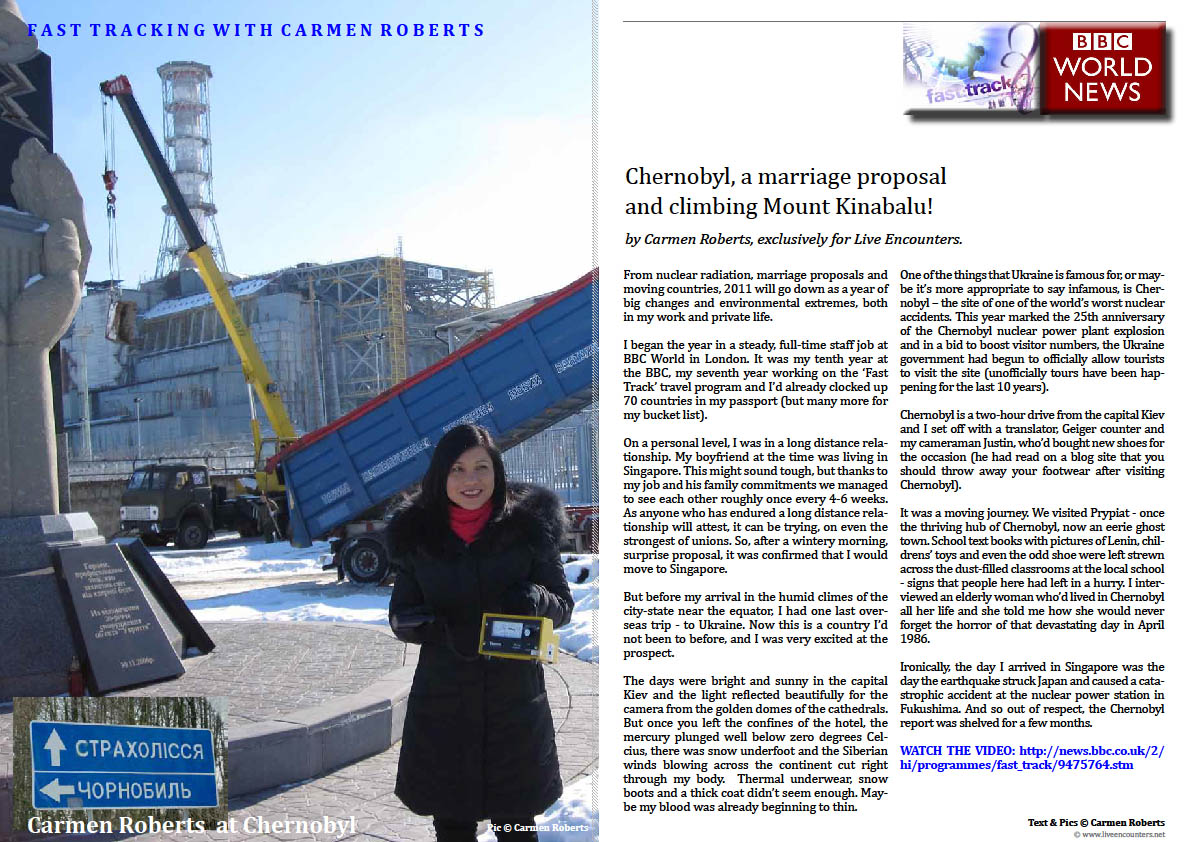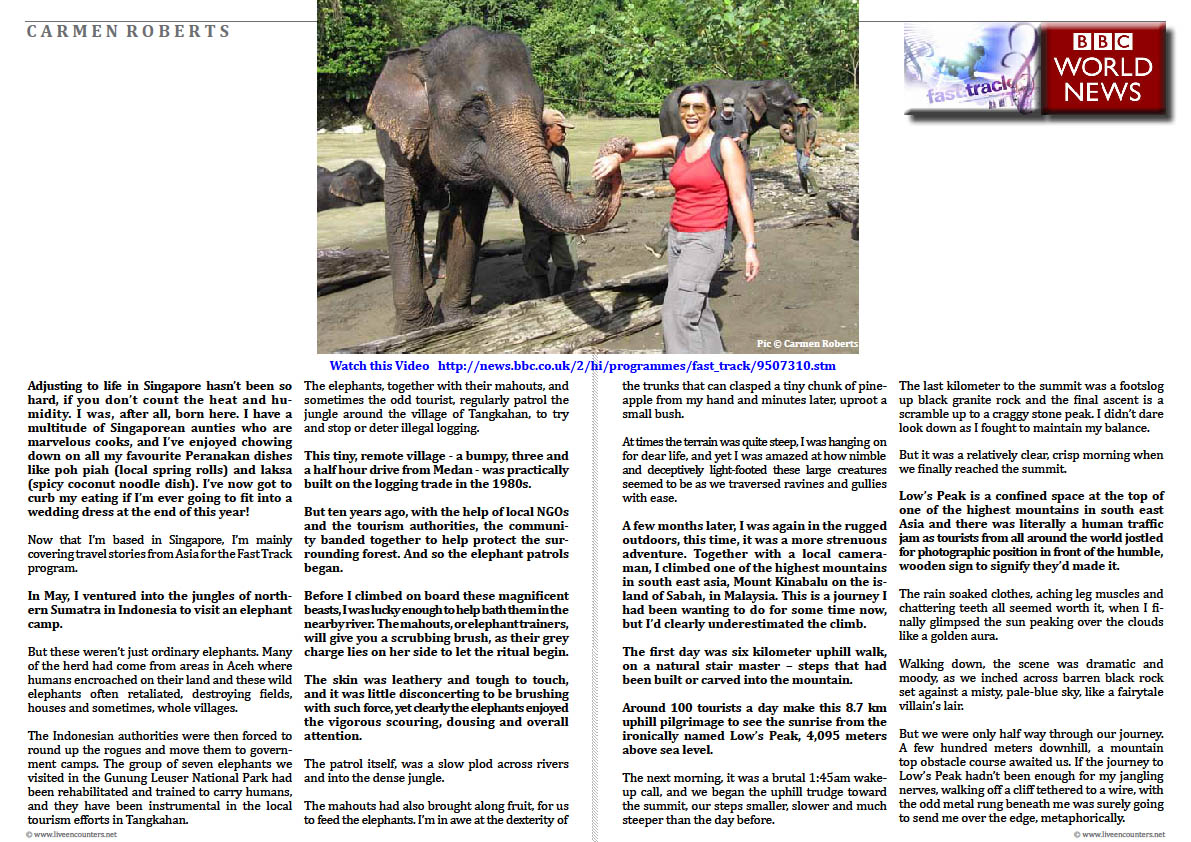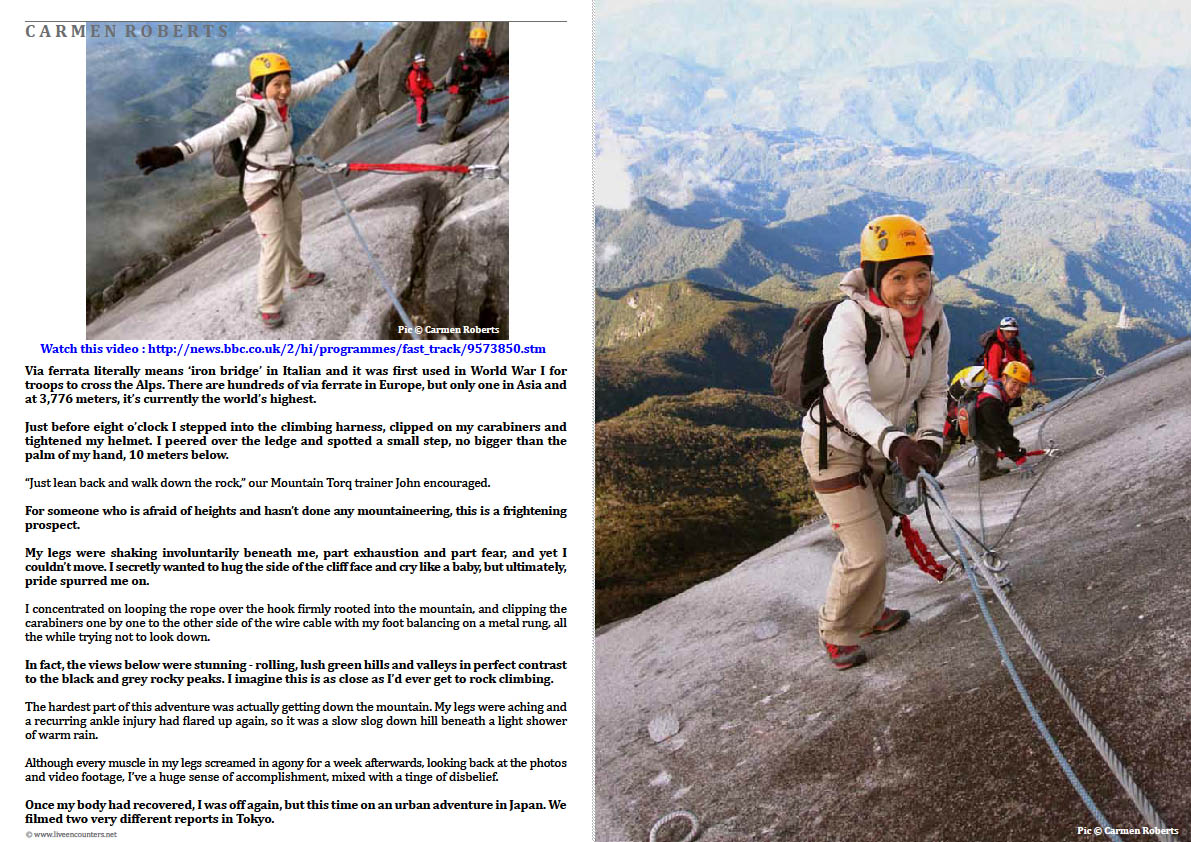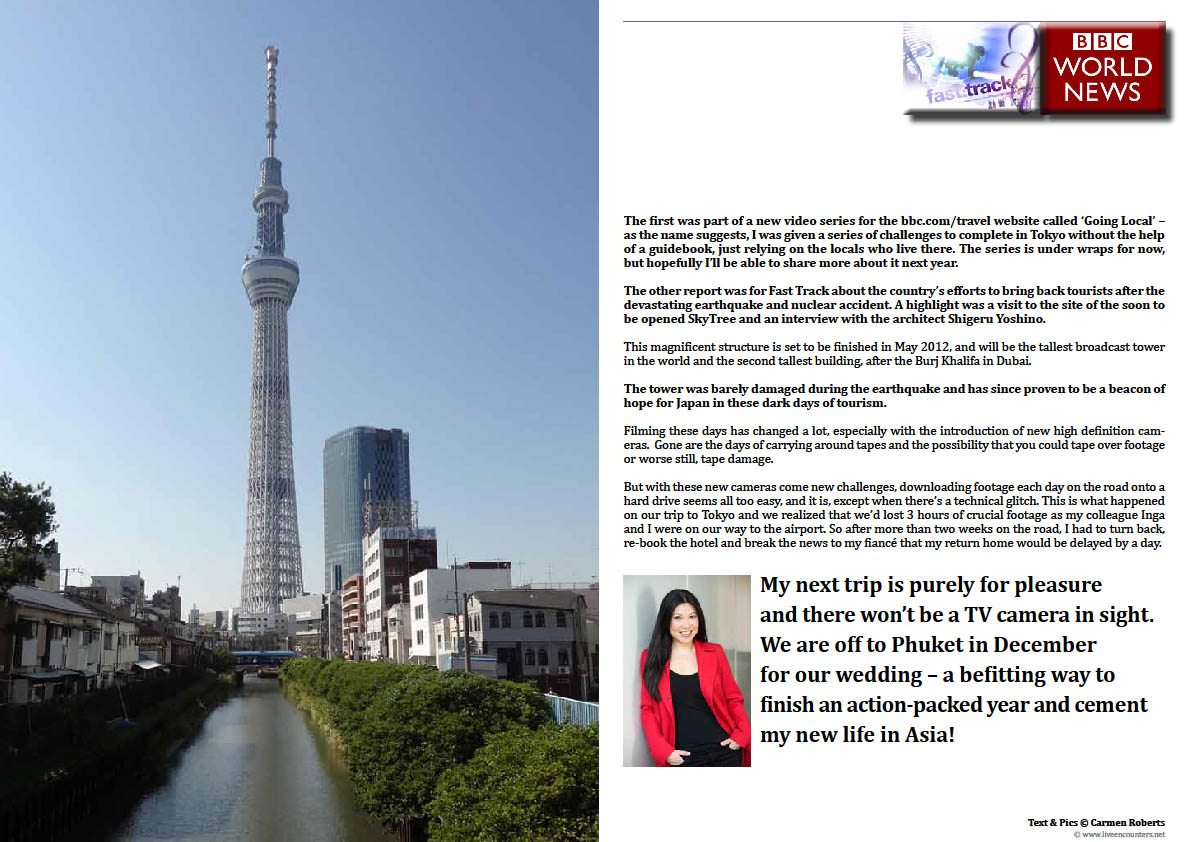
DECEMBER 2011
Carmen Roberts has been a journalist for Fast Track, BBC World’s flagship travel programme since 2003 and has reported from over 60 countries. After the Asian Tsunami on Boxing Day 2004, Carmen cut short her holiday in Langkawi, Malaysia to report from the devastated resort town of Phuket. Carmen’s most recent reports about liquor licensing and buying property in Bali was telecast on Fast Track. http://www.bbc.co.uk
Read other Carmen Roberts articles in Live Encounters Magazine:
Fast Tracking
It’s just me and my small camera
Dancing with criminals in jail !
A Working Holiday
Chernobyl and a marriage proposal
Off the beaten track in Japan
Where are you from?
Chernobyl, a marriage proposal and climbing Mount Kinabalu!
From nuclear radiation, marriage proposals and moving countries, 2011 will go down as a year of big changes and environmental extremes, both in my work and private life.
I began the year in a steady, full-time staff job at BBC World in London. It was my tenth year at the BBC, my seventh year working on the ‘Fast Track’ travel program and I’d already clocked up 70 countries in my passport (but many more for my bucket list).
On a personal level, I was in a long distance relationship. My boyfriend at the time was living in Singapore. This might sound tough, but thanks to my job and his family commitments we managed to see each other roughly once every 4-6 weeks. As anyone who has endured a long distance relationship will attest, it can be trying, on even the strongest of unions. So, after a wintery morning, surprise proposal, it was confirmed that I would move to Singapore.
But before my arrival in the humid climes of the city-state near the equator, I had one last overseas trip – to Ukraine. Now this is a country I’d not been to before, and I was very excited at the prospect.
The days were bright and sunny in the capital Kiev and the light reflected beautifully for the camera from the golden domes of the cathedrals. But once you left the confines of the hotel, the mercury plunged well below zero degrees Celcius, there was snow underfoot and the Siberian winds blowing across the continent cut right through my body. Thermal underwear, snow boots and a thick coat didn’t seem enough. Maybe my blood was already beginning to thin.
One of the things that Ukraine is famous for, or maybe it’s more appropriate to say infamous, is Chernobyl – the site of one of the world’s worst nuclear accidents. This year marked the 25th anniversary of the Chernobyl nuclear power plant explosion and in a bid to boost visitor numbers, the Ukraine government had begun to officially allow tourists to visit the site (unofficially tours have been happening for the last 10 years).
Chernobyl is a two-hour drive from the capital Kiev and I set off with a translator, Geiger counter and my cameraman Justin, who’d bought new shoes for the occasion (he had read on a blog site that you should throw away your footwear after visiting Chernobyl).
It was a moving journey. We visited Prypiat – once the thriving hub of Chernobyl, now an eerie ghost town. School text books with pictures of Lenin, childrens’ toys and even the odd shoe were left strewn across the dust-filled classrooms at the local school – signs that people here had left in a hurry. I interviewed an elderly woman who’d lived in Chernobyl all her life and she told me how she would never forget the horror of that devastating day in April 1986.
Ironically, the day I arrived in Singapore was the day the earthquake struck Japan and caused a catastrophic accident at the nuclear power station in Fukushima. And so out of respect, the Chernobyl report was shelved for a few months.
Adjusting to life in Singapore hasn’t been so hard, if you don’t count the heat and humidity. I was, after all, born here. I have a multitude of Singaporean aunties who are marvelous cooks, and I’ve enjoyed chowing down on all my favourite Peranakan dishes like poh piah (local spring rolls) and laksa (spicy coconut noodle dish). I’ve now got to curb my eating if I’m ever going to fit into a wedding dress at the end of this year!
Now that I’m based in Singapore, I’m mainly covering travel stories from Asia for the Fast Track program.
In May, I ventured into the jungles of northern Sumatra in Indonesia to visit an elephant camp.
But these weren’t just ordinary elephants. Many of the herd had come from areas in Aceh where humans encroached on their land and these wild elephants often retaliated, destroying fields, houses and sometimes, whole villages.
The Indonesian authorities were then forced to round up the rogues and move them to government camps. The group of seven elephants we visited in the Gunung Leuser National Park had been rehabilitated and trained to carry humans, and they have been instrumental in the local tourism efforts in Tangkahan.
The elephants, together with their mahouts, and sometimes the odd tourist, regularly patrol the jungle around the village of Tangkahan, to try and stop or deter illegal logging.
This tiny, remote village – a bumpy, three and a half hour drive from Medan – was practically built on the logging trade in the 1980s.
But ten years ago, with the help of local NGOs and the tourism authorities, the community banded together to help protect the surrounding forest. And so the elephant patrols began.
Before I climbed on board these magnificent beasts, I was lucky enough to help bath them in the nearby river. The mahouts, or elephant trainers, will give you a scrubbing brush, as their grey charge lies on her side to let the ritual begin.
The skin was leathery and tough to touch, and it was little disconcerting to be brushing with such force, yet clearly the elephants enjoyed the vigorous scouring, dousing and overall attention.
The patrol itself, was a slow plod across rivers and into the dense jungle.
The mahouts had also brought along fruit, for us to feed the elephants. I’m in awe at the dexterity of the trunks that can clasped a tiny chunk of pineapple from my hand and minutes later, uproot a small bush.
At times the terrain was quite steep, I was hanging on for dear life, and yet I was amazed at how nimble and deceptively light-footed these large creatures seemed to be as we traversed ravines and gullies with ease.
A few months later, I was again in the rugged outdoors, this time, it was a more strenuous adventure. Together with a local cameraman, I climbed one of the highest mountains in south east Asia, Mount Kinabalu on the island of Sabah, in Malaysia. This is a journey I had been wanting to do for some time now, but I’d clearly underestimated the climb.
The first day was six kilometer uphill walk, on a natural stair master – steps that had been built or carved into the mountain.
Around 100 tourists a day make this 8.7 km uphill pilgrimage to see the sunrise from the ironically named Low’s Peak, 4,095 meters above sea level.
The next morning, it was a brutal 1:45am wake-up call, and we began the uphill trudge toward the summit, our steps smaller, slower and much steeper than the day before.
The last kilometer to the summit was a footslog up black granite rock and the final ascent is a scramble up to a craggy stone peak. I didn’t dare look down as I fought to maintain my balance.
But it was a relatively clear, crisp morning when we finally reached the summit.
Low’s Peak is a confined space at the top of one of the highest mountains in south east Asia and there was literally a human traffic jam as tourists from all around the world jostled for photographic position in front of the humble, wooden sign to signify they’d made it.
The rain soaked clothes, aching leg muscles and chattering teeth all seemed worth it, when I finally glimpsed the sun peaking over the clouds like a golden aura.
Walking down, the scene was dramatic and moody, as we inched across barren black rock set against a misty, pale-blue sky, like a fairytale villain’s lair.
But we were only half way through our journey. A few hundred meters downhill, a mountain top obstacle course awaited us. If the journey to Low’s Peak hadn’t been enough for my jangling nerves, walking off a cliff tethered to a wire, with the odd metal rung beneath me was surely going to send me over the edge, metaphorically.
Via ferrata literally means ‘iron bridge’ in Italian and it was first used in World War I for troops to cross the Alps. There are hundreds of via ferrate in Europe, but only one in Asia and at 3,776 meters, it’s currently the world’s highest.
Just before eight o’clock I stepped into the climbing harness, clipped on my carabiners and tightened my helmet. I peered over the ledge and spotted a small step, no bigger than the palm of my hand, 10 meters below.
“Just lean back and walk down the rock,” our Mountain Torq trainer John encouraged.
For someone who is afraid of heights and hasn’t done any mountaineering, this is a frightening prospect.
My legs were shaking involuntarily beneath me, part exhaustion and part fear, and yet I couldn’t move. I secretly wanted to hug the side of the cliff face and cry like a baby, but ultimately, pride spurred me on.
I concentrated on looping the rope over the hook firmly rooted into the mountain, and clipping the carabiners one by one to the other side of the wire cable with my foot balancing on a metal rung, all the while trying not to look down.
In fact, the views below were stunning – rolling, lush green hills and valleys in perfect contrast to the black and grey rocky peaks. I imagine this is as close as I’d ever get to rock climbing.
The hardest part of this adventure was actually getting down the mountain. My legs were aching and a recurring ankle injury had flared up again, so it was a slow slog down hill beneath a light shower of warm rain.
Although every muscle in my legs screamed in agony for a week afterwards, looking back at the photos and video footage, I’ve a huge sense of accomplishment, mixed with a tinge of disbelief.
Once my body had recovered, I was off again, but this time on an urban adventure in Japan. We filmed two very different reports in Tokyo.
The first was part of a new video series for the bbc.com/travel website called ‘Going Local’ – as the name suggests, I was given a series of challenges to complete in Tokyo without the help of a guidebook, just relying on the locals who live there. The series is under wraps for now, but hopefully I’ll be able to share more about it next year.
The other report was for Fast Track about the country’s efforts to bring back tourists after the devastating earthquake and nuclear accident. A highlight was a visit to the site of the soon to be opened SkyTree and an interview with the architect Shigeru Yoshino.
This magnificent structure is set to be finished in May 2012, and will be the tallest broadcast tower in the world and the second tallest building, after the Burj Khalifa in Dubai.
The tower was barely damaged during the earthquake and has since proven to be a beacon of hope for Japan in these dark days of tourism.
Filming these days has changed a lot, especially with the introduction of new high definition cameras. Gone are the days of carrying around tapes and the possibility that you could tape over footage or worse still, tape damage.
But with these new cameras come new challenges, downloading footage each day on the road onto a hard drive seems all too easy, and it is, except when there’s a technical glitch. This is what happened on our trip to Tokyo and we realized that we’d lost 3 hours of crucial footage as my colleague Inga and I were on our way to the airport. So after more than two weeks on the road, I had to turn back, re-book the hotel and break the news to my fiancé that my return home would be delayed by a day.
My next trip is purely for pleasure and there won’t be a TV camera in sight. We are off to Phuket in December for our wedding – a befitting way to finish an action-packed year and cement my new life in Asia!
© Carmen Roberts





